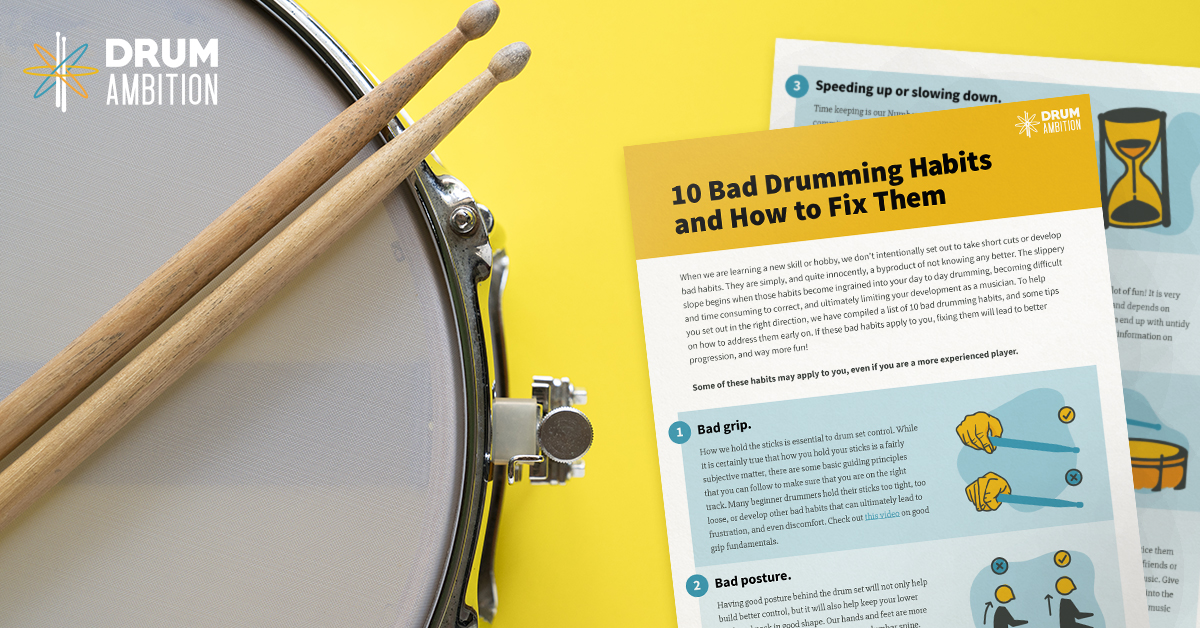Buying your first drum set is an exhilarating moment, and the day those boxes arrive at your door is one you'll never forget.
To be truly inspired to play an instrument, it has to sound good, and this is where some beginner drummers need a little help. Your new drums may need to be assembled from the box, including drum head fitting and tuning, or you may have purchased a pre-owned drum set that needs some TLC. Some low maintenance and low-cost solutions are available to help you.
Helpful related articles:
The importance of good tuning.
Good tuning is key, and this presents quite a challenge to most beginner drummers because it takes experience to do well. Various online tutorials can help you, but the reality is that learning to tune takes time, and most people want to start playing a nicely tuned drum set as quickly as possible. If you want to make your drums sound good without too much trial and error, we highly recommend purchasing a DrumDial. These are tuning tools that measure the drum head's tightness using tympanic pressure. Using the reading from a simple clock-face display, you can tune a drum set to a good degree of accuracy in a fraction of the time it would take to do so by ear. We've written more about the DrumDial, with a link on where to purchase them in this article.
Are the drum heads up to the job?
If you have purchased a new drum set, it will likely come with factory heads. These are the drum heads that come as standard, and while they are mostly of good quality, they are rarely as good as the specialist heads made by companies such as Evans, Remo, or Aquarian. A drum head is a modern term for what many called drum skins. We've come a long way in technology and ethics since the days of calf-skin heads. Upgrading these factory drum heads can greatly enhance the sound of your drums. If you have purchased a used set, check the drum heads' condition. It should be easy to see if they are old and need replacing, with telltale signs such as pitting (small dents on the surface), scratches, or discoloring.
What type of drum heads can enhance the sound?
Let's start with your toms. A common complaint from beginner drummers is that their toms ring too much. Given as drums are designed to resonate, this is not unusual, but there are some measures you can take to minimize the resonance and give your toms a deeper, more attractive tone. If new, your toms will most likely come with a single-ply drum head on both the top (batter) and bottom (resonant-side) of the drum. Fitting a two-ply head (Evans G2 or Remo Emperor) to the batter side of the drum will give you a great sound, slightly less ring, and a more controlled tone. Much of this depends on the drum tuning, as discussed above. Double-ply bass drum batter heads can also give your bass drum a deeper, more controlled sound and are definitely worth considering. Again, the resonant, or front bass drum head, rarely needs to be substituted.
Does it matter if the drum heads are coated or clear?
At first, it can be tough to discern between coated and clear heads. Coated drum heads are generally said to give a slightly drier sound and are definitely preferable in jazz applications where you might be using brushes. The majority of starter drum sets come with clear heads (except for the snare drum), and frankly, unless you prefer the cosmetic look of coated heads, they are fine.
What about the snare drum?
In particular, the snare drum can sound very abrasive without the right head selection, tuning, and set-up. Fortunately, most snare drums come assembled from the factory, so you don't have to worry about fitting the snare wires. A good single-ply coated drum head is usually recommended for the snare drum (Like an Evans G1 Coated or a Remo Ambassador). If it rings too much, you can always look at some of the dampening options we outline below. If the snare wires seem to be buzzing too much after the initial stroke, then try tightening them slightly using the snare strainer attached to the side of the drum. If your snare drum is pre-owned, always check the snare wires' condition. They typically have 20 strands, and missing, broken, or bent wires can affect the sound.
What is snare buzz, and how can it be controlled?
Sometimes, even when the snare drum is set up well, the snare wires will buzz lightly when you play the toms, particularly the higher-pitched smaller toms. This is called snare buzz and is a natural event caused by certain frequencies from other drums. The tone of other instruments, particularly bass guitars, can also trigger it. This is perfectly natural and should not be a concern. Ensuring your snare drum wires are tight enough will help minimize this, but be careful not to over-tighten your wires, as this will choke the drum.
Sound dampening.
Applying additional dampening to your drums can also help control sound. This can be as simple and low maintenance as placing a household pillow inside the bass drum. Ideally, the pillow touches both the batter and resonant heads, and this additional dampening will give you a more controlled sound. It will also give the drum a better feel when playing the bass drum pedal. Even when bass drums are fitted with so-called pre-damped heads, they can still sound very boomy without internal dampening. Snare drums and toms can be controlled by applying putty-type products such as Moongel directly to the batter side drum head, next to the rim. Tone Rings can also be applied to the top of the drums. Typically one inch in diameter, these plastic rings significantly reduce the ring and resonance. Check out this article for tips on sound dampening, including recommended products and where to buy them.
Can the sound of the cymbals be enhanced?
Budget cymbal packs do not tend to be the most musical option available. That's the politically correct way of saying that they can sound nasty! Remember, if you don't like the sound of your cymbals, you are less likely to want to hit them. Given as there are no effective options to alter your acoustic cymbal sound, we recommend upgrading basic cymbal sets and budgeting for this in your initial purchase. Our article on the five common mistakes made when purchasing drums may help you here.
We are here to help.
If you have any questions about this article, please feel free to email [email protected].



